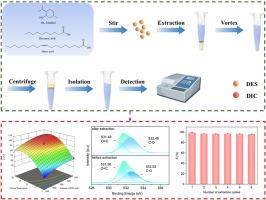涡旋辅助微萃取双氯芬酸钠的高效可回收非离子三元疏水深共晶溶剂
IF 5.8
2区 化学
Q2 CHEMISTRY, MULTIDISCIPLINARY
引用次数: 0
摘要
本文提出了一种基于非离子三元疏水深共晶溶剂(DESs)的涡辅助液-液微萃取(VA-LLME)技术,用于高效提取双氯芬酸钠(DIC)。在传统二元体系的基础上,系统设计了四种三元疏水DES(两种酸基两种醇基)。其中,选取摩尔比为1:2:1的薄荷醇:癸酸:油酸([Men][DA][OA])作为萃取剂,通过傅里叶变换红外光谱(FT-IR)和1H核磁共振(1H NMR)分析证实其结构特征。考察了离子强度、溶液pH、漩涡时间、DES体积等因素的影响。通过RSM优化得到最佳提取条件,提取率可达99.7%。此外,[Men][DA][OA](1:2:1)通过反萃取再生表现出卓越的可回收性,在连续6次循环后,萃取效率仍保持96.3%。加样回收率为82.3% ~ 97.2%,相对标准偏差小于3.6%。采用1H NMR、x射线光电子能谱(XPS)和荧光显微镜对其提取机理进行了研究。结果表明,水-DES (W/DES)微观结构的形成对萃取过程起着至关重要的作用。此外,通过AGREEprep和ComplexGAPI工具验证了所开发方法的绿色度。这项工作建立了一个高效和可持续的微萃取平台,结合了三元DES设计和节能涡流辅助混合的优势,展示了环境基质中药物污染物修复的巨大潜力。本文章由计算机程序翻译,如有差异,请以英文原文为准。

High-efficiency and recyclable non-ionic ternary hydrophobic deep eutectic solvent for vortex-assisted microextraction of diclofenac sodium from water
This work presents a novel vortex-assisted liquid-liquid microextraction (VA-LLME) technique based on non-ionic ternary hydrophobic deep eutectic solvents (DESs) for the highly efficient extraction of diclofenac sodium (DIC). Departing from conventional binary systems, four kinds of ternary hydrophobic DES (two acid-based two alcohol-based) were systematically designed. Among them, menthol:decanoic acid:oleic acid ([Men][DA][OA]) with a molar ratio of 1:2:1 was selected as the extractant, with its structural characteristics confirmed through Fourier transform-infrared spectroscopy (FT-IR) and 1H Nuclear Magnetic Resonance (1H NMR) analysis. The effects of ionic strength, solution pH, vortex time, and DES volume were investigated. The optimal extraction conditions were obtained by RSM optimization and the extraction efficiency could reach 99.7 %. In addition, the [Men][DA][OA] (1:2:1) demonstrated exceptional recyclability through back-extraction regeneration, maintaining extraction efficiency of 96.3 % after six successive cycles. The recovery experiments were also carried out and satisfactory recoveries (82.3 %–97.2 %) were obtained with relative standard deviations below 3.6 %. The extraction mechanism was investigated through the use of 1H NMR, X-ray photoelectron spectroscopy (XPS), and fluorescence microscope. The results indicated that the formation of water-in-DES (W/DES) microstructure played a crucial role in the extraction process. Furthermore, the greenness of the developed method was confirmed by AGREEprep and ComplexGAPI tools. This work establishes an efficient and sustainable microextraction platform that combines the advantages of ternary DES design with energy-efficient vortex-assisted mixing, demonstrating significant potential for pharmaceutical contaminant remediation in environmental matrices.
求助全文
通过发布文献求助,成功后即可免费获取论文全文。
去求助
来源期刊

Sustainable Chemistry and Pharmacy
Environmental Science-Pollution
CiteScore
8.20
自引率
6.70%
发文量
274
审稿时长
37 days
期刊介绍:
Sustainable Chemistry and Pharmacy publishes research that is related to chemistry, pharmacy and sustainability science in a forward oriented manner. It provides a unique forum for the publication of innovative research on the intersection and overlap of chemistry and pharmacy on the one hand and sustainability on the other hand. This includes contributions related to increasing sustainability of chemistry and pharmaceutical science and industries itself as well as their products in relation to the contribution of these to sustainability itself. As an interdisciplinary and transdisciplinary journal it addresses all sustainability related issues along the life cycle of chemical and pharmaceutical products form resource related topics until the end of life of products. This includes not only natural science based approaches and issues but also from humanities, social science and economics as far as they are dealing with sustainability related to chemistry and pharmacy. Sustainable Chemistry and Pharmacy aims at bridging between disciplines as well as developing and developed countries.
 求助内容:
求助内容: 应助结果提醒方式:
应助结果提醒方式:


